
Hans Aichinger Stephan Huber Per Kirkeby Thomas Taube Ibrahim Mahama The Inner Land
Leipzig 26 Sep – 19 Dec 2020
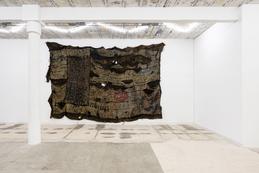
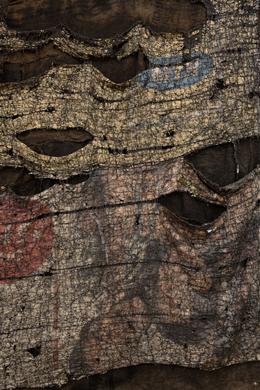
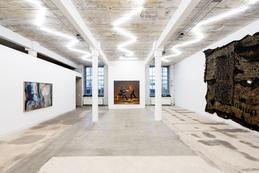
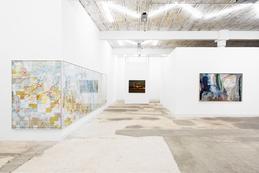
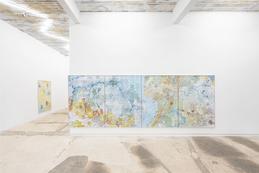
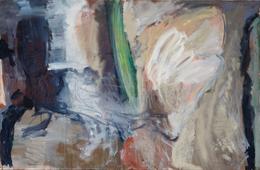
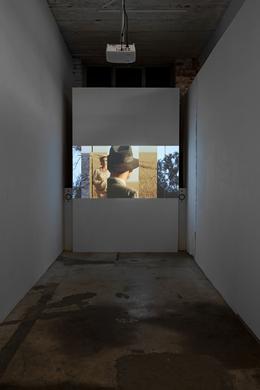
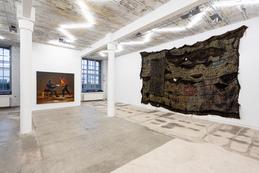
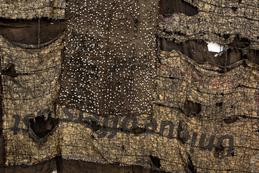
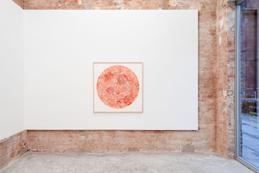
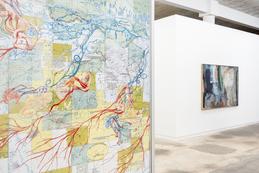
For most city dwellers, a landscape is a space more often experienced as a state of mind, rather than an embodied experience. We carry with us topographies into which we can project ourselves. These spaces, both remembered and imagined, become the terrain of our fantasies and chimera. For migrants, these mental panoramas are not only a refuge for comfort, but also an intrinsic part in the fabric of their identity. In reality everyone is shaped by the landscapes that surround them, both past and present. But through our imagination, we can also access foreign lands never physically inhabited. Through photographs and films, we have a rich library of landscapes we have never experienced in person but that we can dream about. Yet, they remain apathetic: devoid of scent, of temperature, or sound. »The Inner Land« is an exhibition that looks at how imagined spaces inform the work of artists as they explore strategies to represent spaces inhabited by the mind, but not the body.
In Hans Aichinger’s work, figures are caught in a state of rêverie. As the painter represents his subjects with quasi- photographic precision in non-descript spaces devoid of furniture and objects, their facial expressions suggest compelling inner worlds bustling with life.
The Danish artist Per Kirkeby chooses a colourful pallet to paint landscapes as vast fields that retain the subjective perspective of the beholder rather than a faithful reproduction of the picture of a landscape. He does not refer to any particular locations, but rather suggest the experience of being in nature – something emphasized by his preference for large formats that allow the viewers to immerse themselves into his colourful compositions.
Human experience is also at the heart of the practice of the German multidisciplinary artist Stephan Huber. He is particularly interested in the inability of a map to convey the embodied understanding of a landscape as his main avenue of research. In his intricate maps, territories are cut apart and reconfigured into compositions that mix historical figures, clippings of texts, anatomical depictions, and drawn over to suggest a world mediated by culture and history.
The Ghananian artist Ibrahim Mahama takes an equally socially-engaged position. His woven pieces address the labour of foreign workers around the world who serve the myth of a globalized world. Working with a network of collaborators, Mahama recuperates materials from urban environments, shoe boxes, pieces of wood, jute sacks, among other, that he stitches together into impressive structures – at time covering entire buildings. His work addresses the far-away lands where a lot of the products we consume daily are harvested or produced.
Thomas Taube’s artistic practice is defined by a poetic exploration of a landscape in crisis. His work is interested in the imperceptible forces that have a destructive effect. Primarily working with film, he refers to the simultaneous and entangled forces that have a covert impact on human life.
Brought together in this project, »The Inner Land« proposes contrasting positions that come together into a coherent exploration of humans’ power of imagination and creativity. The project offers a basis for urgent postures of empathy, solidarity and resolution.
— Anaïs Castro
In Hans Aichinger’s work, figures are caught in a state of rêverie. As the painter represents his subjects with quasi- photographic precision in non-descript spaces devoid of furniture and objects, their facial expressions suggest compelling inner worlds bustling with life.
The Danish artist Per Kirkeby chooses a colourful pallet to paint landscapes as vast fields that retain the subjective perspective of the beholder rather than a faithful reproduction of the picture of a landscape. He does not refer to any particular locations, but rather suggest the experience of being in nature – something emphasized by his preference for large formats that allow the viewers to immerse themselves into his colourful compositions.
Human experience is also at the heart of the practice of the German multidisciplinary artist Stephan Huber. He is particularly interested in the inability of a map to convey the embodied understanding of a landscape as his main avenue of research. In his intricate maps, territories are cut apart and reconfigured into compositions that mix historical figures, clippings of texts, anatomical depictions, and drawn over to suggest a world mediated by culture and history.
The Ghananian artist Ibrahim Mahama takes an equally socially-engaged position. His woven pieces address the labour of foreign workers around the world who serve the myth of a globalized world. Working with a network of collaborators, Mahama recuperates materials from urban environments, shoe boxes, pieces of wood, jute sacks, among other, that he stitches together into impressive structures – at time covering entire buildings. His work addresses the far-away lands where a lot of the products we consume daily are harvested or produced.
Thomas Taube’s artistic practice is defined by a poetic exploration of a landscape in crisis. His work is interested in the imperceptible forces that have a destructive effect. Primarily working with film, he refers to the simultaneous and entangled forces that have a covert impact on human life.
Brought together in this project, »The Inner Land« proposes contrasting positions that come together into a coherent exploration of humans’ power of imagination and creativity. The project offers a basis for urgent postures of empathy, solidarity and resolution.
— Anaïs Castro
Artists
- Hans Aichinger
- Stephan Huber
- Per Kirkeby
- Thomas Taube
- Ibrahim Mahama